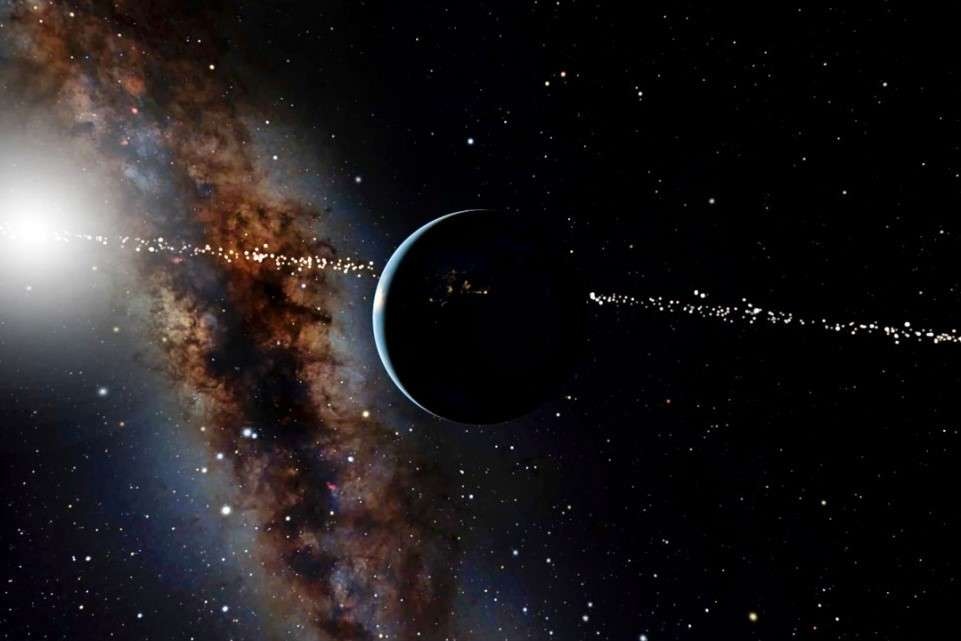Create a free profile to get unlimited access to exclusive videos, sweepstakes, and more!
How many aliens planets can see Earth? More than we first thought

In 2020, a pretty cool research paper was published. In it, the astronomers posited the question: What nearby stars are in the right spots on the sky to see Earth transit the Sun, and therefore any purported aliens living on planets around those stars might know we exist?
I wrote about this paper and how the geometry works at the time, so please take a moment to read that and come back here.
All done? So basically, the most successful method we have to detect exoplanets — aliens worlds orbiting other stars — is the transit method, where we see the planet's orbit edge-on, and once per orbital period the planet passes directly in front of its star, creating a mini-eclipse.
But Earth orbits the Sun in an ellipse, and there are lots of stars that would see our orbit edge-on (a line in the sky we call the ecliptic), so they could easily detect us. That work used data from the TESS and Gaia space observatories to find a little over 1,000 stars where this would work. Of those, two are known to have planets.
However, stars move as they orbit around the Milky Way galaxy. The bulk of that work assumed the stars were stationary, and only looked at motions for a few of them and how that might change the geometry and their perspective. If a star moves up or down relative to the ecliptic, it might not see Earth transits at first, then it will for some time, then it moves too far above the plane to see them any more. How many stars experience an Earth-transit season?
To answer that, the lead astronomer on that research, Lisa Kaltenegger, and her co-author Jackie Faherty have followed up on the original work. They use new results from Gaia, which observes well over a billion stars (!!) to get very accurate measurements of their positions, distances, and movements. An update to the Gaia catalog provides even more accurate data, which were used in this follow-up research.
The authors broaden their search to look for stars that have, have had, or will have the right geometry over a time range of 10,000 years, from 5,000 years ago (when human civilization was getting started) to five millennia hence.
Because this opens things up a bit, they found more stars that fit the criteria. In fact, they find that a total of 2,034 stars within a distance of 100 parsecs (326 light years) from us pass through the Earth's ecliptic plane during that time range; 1,715 from the past 5,000 years and 319 sometime in the next 5,000 years.
Neat! Not too surprisingly, red dwarf stars dominate the results, since these dim bulb stars are by far the most common. Of the ~2,000 stars, they found over 1,500 red dwarfs, about 100 stars only slightly cooler than the Sun, 194 stars like the Sun, and about 100 that are more massive and brighter. In this “Earth Transit Zone” they also found a dozen giant stars, which are in the process of dying, and 109 white dwarfs; stellar cores from stars that were once like the Sun but used up their nuclear fuel, blew off their outer layers, and died.
At the moment, 1,402 stars can see an Earth transit. The breakdown of stellar types in this subgroup is proportional to the overall results.
One of the stars, Ross 128, is only 10 light years away! It's one of the closest stars known, and happens to have an Earth-mass exoplanet orbiting it. Hmmmm. On the other hand, the astronomers find that Earth transits seen from this planet would have ended about 900 years ago, so if there are aliens there looking for technological civilizations, they missed us.
Another one, called Teegarden's Star (mentioned in my earlier article) is about 11 light years away and, while it does not currently see Earth transits, it will starting in the year 2050. It hosts two Earth-mass planets! Hmmmm again. The famous TRAPPIST-1 system — a red dwarf with seven planets orbiting it — will be able to see transits starting about 1,640 years from now.
In total, seven stars of the 2,000 are known to have planets orbiting them (an improvement over the first paper). Some have been in the Earth Transit Zone for thousands of years. Plenty of time to find and spy on us, if anyone is out there. In fact, looking at the statistics of known planets around other stars, they estimate there are over 500 rocky worlds orbiting stars in the overall sample.
A more interesting way to think about all this is asking how many of those stars are within about 100 light years of Earth. Why? Because we've been broadcasting radio waves for about a century. They were weak at first, but got stronger over time, and a planet within that distance could potentially detect our radio, TV, and military signals.
Of all those 2,000 stars, 117 are within that distance. Again, using statistics they estimate about 29 rocky worlds may exist within that sphere.
I like this research. If there are nearby planets with life that may know we're here, then it makes sense we should know which ones they are. There are debates going on about whether we should broadcast our existence to the galaxy or not (a planet full of Klingons of Kzinti or protomolecule builders might not take kindly to us being around), but either way these planets would make decent targets for SETI, the Search for Extraterrestrial Intelligence. It's a big galaxy and we should be looking all over for other brains, but it's nice to have some idea of places we can poke into a little deeper.


























